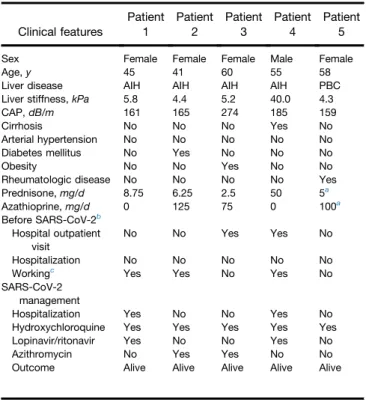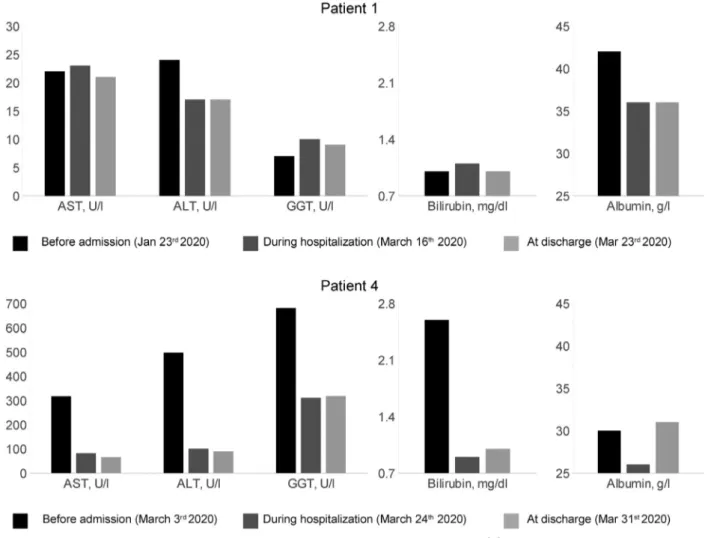Rates of Symptomatic SARS-CoV-2 Infection in Patients With
Autoimmune Liver Diseases in Northern Italy: A Telemedicine
Study
Cristina Rigamonti, Micol Giulia Cittone, Carla De Benedittis, Eleonora Rizzi,
Giuseppe Francesco Casciaro, Mattia Bellan, Pier Paolo Sainaghi, and Mario Pirisi
Department of Translational Medicine, Università del Piemonte Orientale, Novara, Italy; Division of Internal Medicine, Azienda Ospedaliero-Universitaria Maggiore della Carità, Novara, Italy
S
evere acute respiratory syndrome coronavirus 2 (SARS-CoV-2) is a virus responsible for a variety of clinical manifestations that, besides the lungs, can involve several other organs, leading to both mild and severe complications.1–3There is scarce information regarding the interaction between pre-existing liver disease and SARS-CoV-2 infection; specifically, there is no demonstration that patients with autoimmune hepatitis (AIH) and primary biliary cholangitis (PBC) are at higher risk of coronavirus disease 2019 (COVID-19). One major difficulty in addressing these issues has been the limited access to outpatient clinics because of the pandemic, with deferral of all routine follow-up visits.
Here, we report our experience on telemedicine conducted by hepatologists in a tertiary-care Center for Liver Disease of a University Hospital in Northern Italy for a 2-week period during the COVID-19 pandemic.
Methods
From April 1 to 17, 2020, all patients with a previous diagnosis of AIH or PBC who were under follow-up care at our tertiary-care Center for Liver Disease at the Uni-versity Hospital in Novara (in eastern Piedmont, close to Lombardy) were included consecutively in this study. They underwent a telephone survey to state whether they had experienced symptoms related to SARS-CoV-2 infection, had been cured at home, or had been
hospi-talized for COVID-19 during the epidemic
(Supplementary Methods).
Results
Of 141 patients (73 with AIH, 68 with PBC), all except 3 patients (2 with AIH, 1 with PBC) answered the telephone survey described earlier. Demographic and clinical fea-tures of included patients are shown in Supplementary Table 1.
Table 1. Clinical Features of Patients Who Developed Symptomatic SARS-CoV-2 Infection
Clinical features Patient 1 Patient 2 Patient 3 Patient 4 Patient 5
Sex Female Female Female Male Female
Age, y 45 41 60 55 58
Liver disease AIH AIH AIH AIH PBC
Liver stiffness, kPa 5.8 4.4 5.2 40.0 4.3
CAP, dB/m 161 165 274 185 159
Cirrhosis No No No Yes No
Arterial hypertension No No No No No
Diabetes mellitus No Yes No No No
Obesity No No Yes No No
Rheumatologic disease No No No No Yes
Prednisone, mg/d 8.75 6.25 2.5 50 5a Azathioprine, mg/d 0 125 75 0 100a Before SARS-CoV-2b Hospital outpatient visit No No Yes Yes No Hospitalization No No No No No Workingc
Yes Yes No Yes No
SARS-CoV-2 management
Hospitalization Yes No No Yes No
Hydroxychloroquine Yes Yes Yes Yes Yes
Lopinavir/ritonavir Yes No No Yes No
Azithromycin No Yes Yes No No
Outcome Alive Alive Alive Alive Alive
NOTE. Each patient was assigned a number.
AIH, autoimmune hepatitis; CAP, controlled attenuation parameter; PBC, pri-mary biliary cholangitis; SARS-CoV-2, severe acute respiratory syndrome coronavirus 2.
a
Immunosuppressive therapy for undifferentiated connective tissue disease. b
In late February 2020. c
Patients 1 and 2 had been working as a cashier (patient 1 at a restaurant and patient 2 at a grocery store). Patient 4 had been working from home.
Abbreviations used in this paper: AIH, autoimmune hepatitis; COVID-19, coronavirus disease 2019; PBC, primary biliary cholangitis; SARS-CoV-2, severe acute respiratory syndrome coronavirus 2.
Most current article
© 2020 by the AGA Institute 1542-3565/$36.00
https://doi.org/10.1016/j.cgh.2020.05.047
All but 1 AIH patient was in biochemical remission with an immunosuppressive regimen (prednisone with/ without azathioprine).
All PBC patients were on ursodeoxycholic acid treat-ment, 5 patients received obeticholic acid in addition to ursodeoxycholic acid. Five patients (4 with AIH, 1 with PBC) developed symptomatic SARS-CoV-2 infection, diagnosed by a nasal swab. Demographic and clinical features of these patients are shown inTable 1.
Two AIH patients (1 cirrhotic man who had an acute onset of AIH and was under high-dose steroids, as per induction protocol, and a woman in biochemical remission being treated with prednisone) developed respiratory failure as a result of COVID-19 pneumonia with the need for hospitalization. They received com-bination treatment with lopinavir/ritonavir and hydroxychloroquine and fully recovered (Table 1). During hospitalization, their liver enzyme levels were monitored (Figure 1).
Three additional patients (2 with AIH, 1 with PBC) developed a fever and cough without respiratory failure
and were treated at home under mandatory quarantine, and treated with hydroxychloroquine (Table 1) with full recovery. All 3 patients experienced intense fatigue, anosmia, and 1 patient also had diarrhea.
Conclusions
To our knowledge, the real impact of COVID-19 in patients with autoimmune liver diseases has not been fully investigated.4This pandemic has outlined the need to face a deep change in hospital organization to pre-vent a further spread of infection. The European Asso-ciation for the Study of the Liver-European Society of Clinical Microbiology and Infectious Diseases position paper endorsed telemedicine in the outpatient setting to avoid nosocomial dissemination of SARS-CoV-2.5Our study attempted to investigate the outbreak of SARS-CoV-2 infection in a cohort of patients affected by autoimmune liver diseases in a high COVID-19–prevalence area.
Figure 1. Dynamic changes in liver function tests in the 2 hospitalized patients with COVID-19: last available laboratory tests before admission, during hospitalization at day 5 of treatment with lopinavir/ritonavir and hydroxychloroquine, and at hospital discharge after 48 to 72 hours from the end of therapy. Aspartate aminotransferase (AST): normal range, 0 to 40 U/L; alanine aminotransferase (ALT): normal range 0 to 40 U/L; g-glutamyl transpeptidase (GGT): normal range, 0 to 50 U/L; albumin: normal range, 34 to 48 g/L; total bilirubin: 0.3 to 1.2 mg/dL.
Among our study population (N ¼ 138), 5 patients (3.6%) had evidence of SARS-CoV-2 infection.
The overall incidence in our cohort resulted in approximately 7 and 5 times higher than estimated rates in Piedmont and Lombardy (by April 21 was approximately 0.50% and 0.67%, respectively).6,7 However, these findings need to be interpreted with caution because it is likely that true infection rates in the general population have been grossly under-estimated. Moreover, half of the patients presented were older than age 63 years, and only 25% were younger than age 50 years. The patients also were unbalanced with regard to sex, with a large predomi-nance of women. Thus, the extent to which they can be compared with the general reference population is limited. Rates of COVID-19 were 5.6% among patients with AIH (11 and 8 times higher compared with official estimates in Piedmont and Lombardy, respectively) and 1.5% among PBC patients. The patients with AIH suf-fered COVID-19 more frequently than patients with PBC, maybe because of immunosuppressive treatment. Our data on incidence seemed a little bit higher than the preliminary data reported by D’Antiga.8
The outcomes of our patients affected by COVID-19 were favorable. In fact, this study attempted to assess the outbreak and outcome of SARS-CoV-2 infection in all consecutive patients with AIH or PBC followed up in a single center.
In conclusion, our study emphasized the usefulness of telemedicine for maintaining the continuity of care among patients with autoimmune liver diseases during the pandemic. Finally, our study showed quite low rates of symptomatic SARS-CoV-2 infection, with overall favorable outcomes among patients with AIH and PBC.
Supplementary Material
Note: To access the supplementary material accom-panying this article, visit the online version of Clinical Gastroenterology and Hepatology atwww.cghjournal.org, and athttps://doi.org/10.1016/j.cgh.2020.05.047.
References
1. Guan WJ, Ni ZY, Hu Y, et al. Clinical characteristics of coro-navirus disease 2019 in China. N Engl J Med 2020; 382:1708–1720.
2. Livingston E, Bucher K. Coronavirus disease 2019 (COVID-19) in Italy. JAMA 2020;323:1335.
3. Fan, Chen L, Li J, et al. Clinical features of COVID-19-related liver functional abnormality. Clin Gastroenterol Hepatol 2020; 18:1561–1566.
4. Lleo A, Invernizzi P, Lohse AW, et al. Highlights for management of patients with autoimmune liver disease during COVID-19 pandemia. J Hepatol 2020. Epub ahead of print. https://doi. org/10.1016/j.jhep.2020.04.002.
5. Boettler T, Newsome PN, Mondelli MU, et al. Care of patients with liver disease during the COVID-19 pandemic: EASL-ESCMID position paper. J Hepatol Rep 2020;2:100113. 6. Istituto Nazionale di Statistica, Italy. Available from:http://dati.
istat.it/. Accessed April 21, 2020.
7. Ministero della Salute, Italy. Available from:http://www.salute.gov. it/imgs/C_17_notizie_4558_0_file.pdf. Accessed April 21, 2020. 8. D’Antiga L. Coronaviruses and immunosuppressed patients: the
facts during the third epidemic. Liver Transpl 2020;26:832–834.
Reprint requests
Address requests for reprints to: Cristina Rigamonti, MD, PhD, Department of Translational Medicine, Università del Piemonte Orientale UPO, Division of Internal Medicine, AOU Maggiore della Carità, 28100 Novara, Italy. e-mail:
[email protected]; fax: (39) 03213733841. Conflicts of interest
The authors disclose no conflicts.
Supplementary Methods
All patients were asked questions about the following: previous vaccination for influenza virus; job; recent traveling; contact with patients with COVID-19 (family/close friends/colleagues); onset of the following symptoms compatible with SARS-2-CoV infec-tion: fever, cough, chest pain, fatigue, arthralgia, myal-gias, nausea, diarrhea, anosmia, ageusia, headache, syncope, sinusitis, or rhinitis; de novo onset of symptoms of liver disease: pruritus, jaundice, abdominal pain, in-crease of abdominal circumference, or edema; immuno-suppressive drug dosage (steroid and azathioprine) and information about recent modifications or a stable dose
for AIH patients; ursodeoxycholic acid and obeticholic acid dosage and information about recent modifications or a stable dose for PBC patients; and latest laboratory investigations including liver biochemistry. During the telephone call, the hepatologists advised their patients not to reduce or stop ongoing treatment with immuno-suppressive drugs. When necessary, a drug prescription was delivered by a certified hospital e-mail box.
Of 141 patients (73 with AIH, 68 with PBC), all but 3 patients (2 with AIH, 1 with PBC) answered the tele-phone survey. Regarding the 3 patients who we were not able to reach by telephone, we connected with their families and we were reassured about their health status. However, we did not include them in this study.
Supplementary Table 1. Demographic and Clinical Features of Patients Included in the Study
Clinical features AIH (N¼ 71) PBC (N¼ 67) Female, n 60 (84%) 66 (98%) Age, ya 64 (21–87) 63 (37–89) Liver stiffness, kPaa 6.2 (2.4–40.0) 5.9 (2.3–39.5) Liver stiffness,>10 kPa, n 11 (15%) 6 (9%) CAP, dB/ma 223 (137–366) 204 (89–312) CAP,>280 dB/m, n 7 (10%) 3 (4%) Cirrhosis, n 13 (18%) 6 (9%) Decompensated liver disease, n 0 (0%) 0 (0%) Arterial hypertension, n 27 (38%) 24 (36%) Diabetes mellitus, n 14 (20%) 7 (10%) Obesity, n 16 (22%) 14 (21%) Rheumatologic disease, n 1 (1%)b 10 (15%)c Prednisone, mg/da 6.25 (1.25–50) – Azathioprine, mg/da 50 (25–125) –
Vaccination for influenza, n 7 (10%) 5 (7%) Job during COVID-19 pandemic
Working from home or unemployed, n
62 (87%) 64 (95%) Medical doctor or nurse, n 4 1 Salesperson or cashier, n 3 2
AIH, autoimmune hepatitis; CAP, controlled attenuation parameter; COVID-19, coronavirus disease 2019; PBC, primary biliary cholangitis.
a
Median (range). b
Undifferentiated connective tissue disease. c
Eight patients had systemic sclerosis, 1 patient had undifferentiated con-nective tissue disease, and 1 patient had systemic lupus erythematosus.

